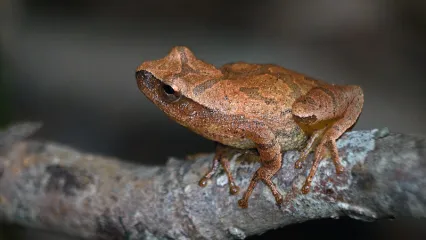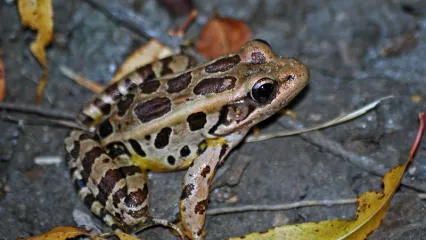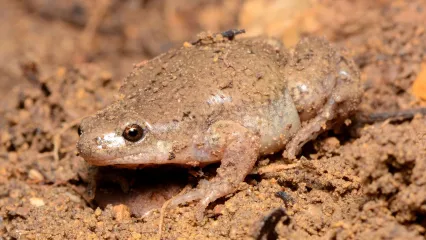
Description
The call of the spring peeper is one of the first harbingers of winter thaws and the impending spring. It is a light yellow to brownish-yellow with a distinctive darker “X” on its back. The limbs are banded, and the venter is cream or white. The iris of the eye is pale gold. Although it is closely related to other chorus frogs in the genus Pseudacris, many of which are ground dwellers, the spring peeper has enlarged toe disks and is frequently found in trees and shrubs.
The small tadpoles are brown to yellowish brown with iridescent green to gold flecking on the body. The fins are relatively high and nearly transparent with light gray mottling, particularly on the outer margins. A clear area is often present around the edge of the tail musculature. The lateral eyes are gold, and the throat and belly are white.
Size
Spring peepers are typically 0.75-1.5 inches in length.
Habitat
Peepers prefer temporary or small permanent ponds or swamps in or near wooded habitat. Males most often call from small trees, shrubs, or tall grass above or near water. In Oklahoma, spring peepers occur in the extreme easternmost counties. They occur throughout most of the eastern U.S., excluding peninsular Florida, to southeastern Manitoba, Canada.
Life Cycle
These frogs begin breeding in winter, usually in February in Oklahoma, but earlier in southern parts of the range. Breeding continues until April, depending on weather. Females deposit 800-1,000 eggs, which are placed singly on aquatic vegetation or in debris on the pond bottom. The eggs hatch in 3-4 days and tadpoles require 45 to 90 days to reach metamorphosis. An unusual aspect of the biology of these frogs is that they can withstand being frozen solid. They produce glucose when their extremities begin to freeze, which causes ice to form in extracellular spaces rather than in their cells.
Like most other frogs, spring peepers feed on small insects.
How To Observe
These small frogs are more easily heard than seen. An occasional individual may be found in ground-level vegetation in forested areas in summer. They can be located during the breeding season at night by listening for their calls in rural areas, then searching for individuals with a headlight or flashlight by homing in on their calls.
(This profile was created by Dr. Laurie Vitt as part of a partnership between the Wildlife Department and the Sam Noble Oklahoma Museum of Natural History. It was funded as part of a larger State Wildlife Grant to survey and inventory amphibians and reptiles of the Wildlife Management Areas of Oklahoma: T-35-P-1.)

